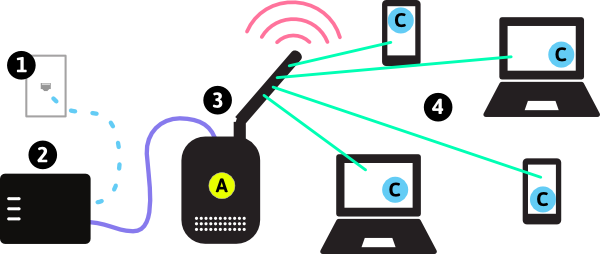What’s Included with Active/Passive Onsite Wireless Site Survey
Conducting both active and passive onsite wireless site surveys ensures a thorough assessment of the wireless network's performance and reliability. These surveys provide valuable insights into optimizing coverage, minimizing interference, enhancing security, and improving overall user experience. By implementing the findings and recommendations from these surveys, organizations can achieve a robust and resilient wireless infrastructure that meets their operational needs effectively.
Throughput testing follows, evaluating the actual data transmission speeds and network performance under realistic usage conditions. These tests provide insights into the network's capacity and help optimize AP configuration for optimal performance and reliability.
One of the fundamental aspects of an active survey is determining the optimal locations for access points (APs) based on the physical layout of the environment. This process involves conducting site walkthroughs to identify potential obstacles, such as walls, columns, or other physical barriers, that can impact signal propagation. By strategically placing APs, network engineers aim to achieve uniform coverage throughout the surveyed area while minimizing areas of signal attenuation or dead zones.

#1. Signal Strength and Throughput Testing:
Once AP placement is determined, signal strength measurements are conducted across various locations to assess coverage uniformity and identify areas with weak signal strength.
The exercise unfolds in real-time, with facilitators introducing new challenges and decisions as the scenario progresses. Participants must collaborate to assess the situation, make decisions under pressure, and implement response protocols to contain the simulated threat. Post-exercise, a comprehensive debriefing session evaluates the organization's performance, identifies areas for improvement, and updates incident response plans accordingly.
The proliferation of Internet of Things (IoT) devices and smart technologies in diverse environments require tailored network designs and optimized connectivity solutions. Onsite surveys will prioritize IoT device compatibility, network scalability, and security measures to support interconnected smart environments.
The integration of 5G technology and adoption of Wi-Fi 6 standards offer enhanced data speeds, increased network capacity, and improved latency performance. Onsite surveys will focus on optimizing 5G and Wi-Fi 6 deployments to support next-generation connectivity requirements.
#2. Resource and Expertise Requirements:
Conducting comprehensive onsite surveys requires specialized tools, equipment, and technical expertise in RF engineering, network architecture, and wireless technology. Investing in training, partnering with experienced service providers, or leveraging advanced surveying tools and software enhances survey accuracy and effectiveness
Onsite surveys should consider the integration and compatibility of new network components, APs, and network management systems with existing IT infrastructure and organizational workflows. Seamless integration minimizes disruption, facilitates deployment efficiency, and supports long-term network sustainability.
Wireless networks operate in dynamic and fluctuating conditions influenced by user mobility, device density, and changing RF interference sources. Ongoing monitoring, periodic surveys, and proactive network management are necessary to maintain optimal network performance and adapt to evolving network demands.

Scenario design is critical in ensuring that tabletop exercises are relevant and realistic. Scenarios should reflect current and emerging cyber threats faced by healthcare organizations, such as ransomware attacks, phishing campaigns, or insider threats. The scenario should challenge participants while aligning with organizational goals and priorities for cybersecurity.
Diversity and serendipity in recommendations are also important aspects that enhance user engagement. Ensuring that recommendations include a variety of content and occasionally introduce users to unexpected but interesting items prevents monotony and encourages exploration of new interests.
Onsite surveys assist organizations in meeting regulatory compliance requirements and industry standards related to wireless network performance, security, and data privacy. Compliance with regulatory guidelines enhances organizational credibility, mitigates legal risks, and fosters trust among stakeholders and customers..
Onsite surveys cater to diverse applications and industries, including corporate offices, educational institutions, healthcare facilities, hospitality venues, and public spaces. Tailored network design and optimization address specific connectivity needs, operational requirements, and user expectations across various environment.
The complexity of the physical environment, including building layout, construction materials, and potential RF obstacles, can impact signal propagation and coverage uniformity. Conducting thorough site assessments and considering environmental factors are essential for accurate survey results and effective network design.
#3. Effective Interference Management:
By analyzing RF interference sources and implementing interference mitigation techniques, onsite surveys minimize signal degradation caused by neighboring networks, non-Wi-Fi devices, and environmental factors. This enhances signal clarity and stability, ensuring reliable connectivity for critical applications.
hrough thorough signal strength testing, throughput analysis, and interference mitigation strategies, onsite surveys optimize network performance, data transmission efficiency, and overall network reliability. This results in improved data speeds, reduced latency, and enhanced user productivity.